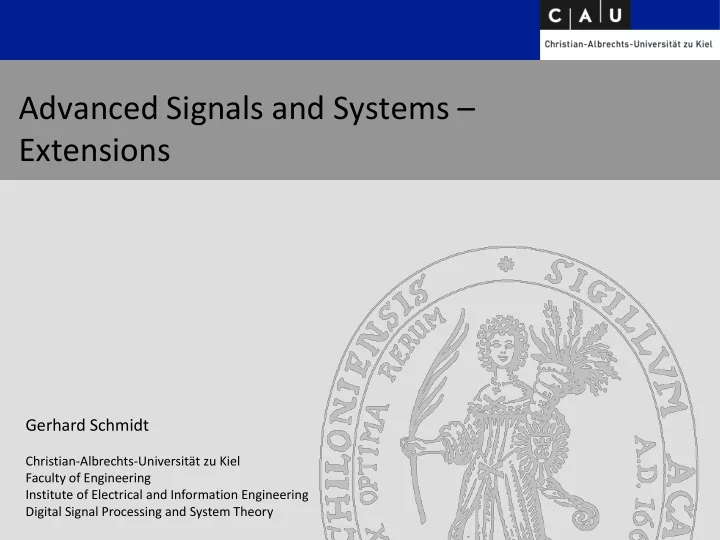

Advanced Signals and Systems – Extensions Gerhard Schmidt Christian-Albrechts-Universität zu Kiel Faculty of Engineering Institute of Electrical and Information Engineering Digital Signal Processing and System Theory Digital Signal Processing and System Theory | Advanced Signals and Systems | Extensions
Contents of the Lecture Entire Semester: Introduction Discrete signals and random processes Spectra Discrete systems Idealized linear, shift-invariant systems Hilbert transform State-space description and system realizations Extensions Digital Signal Processing and System Theory | Advanced Signals and Systems | Extensions Slide VIII-2 Digital Signal Processing and System Theory | Advanced Signals and Systems | Extensions
Contents of this Part Extensions All-pass filters Digital Signal Processing and System Theory | Advanced Signals and Systems | Extensions Slide VIII-3 Digital Signal Processing and System Theory | Advanced Signals and Systems | Extensions
Extensions All-Pass Filters – Part 1 Symmetry of poles and/or zeros If some zeros or poles show certain magnitude or phase relations , special types of systems can be created. We will start first with pairs of zeros that have the following restriction: In a pole-zero plot we obtain the following behavior: Digital Signal Processing and System Theory | Advanced Signals and Systems | Extensions Slide VIII-4 Digital Signal Processing and System Theory | Advanced Signals and Systems | Extensions
Extensions All-Pass Filters – Part 2 Symmetry of poles and/or zeros (continued) If we look at the magnitudes of both zero contributions we obatin: … derivation on the blackboard … For the phase of the connection of both zeros we get: (affin) linear with respect to the normalized frequency! Digital Signal Processing and System Theory | Advanced Signals and Systems | Extensions Slide VIII-5 Digital Signal Processing and System Theory | Advanced Signals and Systems | Extensions
Extensions All-Pass Filters – Part 3 Symmetry of poles and/or zeros (continued) Now we have a look at pole-zero combinations that exhibit the following relation: In pole-zero plots those combinations look like this: Be aware that stability has to be ensured, meaning that all poles have to be inside the unit circle and thus all zeros must be outside of it! Digital Signal Processing and System Theory | Advanced Signals and Systems | Extensions Slide VIII-6 Digital Signal Processing and System Theory | Advanced Signals and Systems | Extensions
Extensions All-Pass Filters – Part 4 Symmetry of poles and/or zeros (continued) For the magnitudes we get: Less important are here the phase relations. The magnitude relation that is shown before, however, leads to a constant magnitude contribution of the pole-zero combination (not dependent on frequency). Systems with such a pole-zero relation exhibit a constant magnitude frequency response. They are called all-pass systems , since all frequency can pass such a system with the same gain. Digital Signal Processing and System Theory | Advanced Signals and Systems | Extensions Slide VIII-7 Digital Signal Processing and System Theory | Advanced Signals and Systems | Extensions
Extensions All-Pass Filters – Part 5 Minimum-phase Systems If a system has all its zeros within the unit circle it is called a minimum-phase system . Digital Signal Processing and System Theory | Advanced Signals and Systems | Extensions Slide VIII-8 Digital Signal Processing and System Theory | Advanced Signals and Systems | Extensions
Extensions All-Pass Filters – Part 6 Maximum-phase Systems Systems that have all zeros outside the unit circle are called maximum-phase systems . Consequence: Stable all-pass filters are maximum-phase systems. Digital Signal Processing and System Theory | Advanced Signals and Systems | Extensions Slide VIII-9 Digital Signal Processing and System Theory | Advanced Signals and Systems | Extensions
Extensions All-Pass Filters – Part 7 Mixed-phase Systems Systems with zeros inside and outside the unit circle are called mixed-phase systems . They can be decomposed into a minimum-phase system and an all-pass system . For the magnitude frequency response we get: The additional poles and zeros in compensate with the corresponding poles and zeros of the all-pass system after cascading both systems. Digital Signal Processing and System Theory | Advanced Signals and Systems | Extensions Slide VIII-10 Digital Signal Processing and System Theory | Advanced Signals and Systems | Extensions
Extensions All-Pass Filters – Part 8 Mixed-phase Systems (continued) Example of a mixed-phase system: Please determine the minimum-phase and the all-pass part of the system! Solution on the blackboard (after individual trials first) Digital Signal Processing and System Theory | Advanced Signals and Systems | Extensions Slide VIII-11 Digital Signal Processing and System Theory | Advanced Signals and Systems | Extensions
Extensions Contents of the Extension Part This part: All-pass filters No next part – that’s it … Enjoy applying your new knowledge – in the upcoming lectures, during a lab, while working on your thesis and most importantly during your profession as an engineer. The DSS team Digital Signal Processing and System Theory | Advanced Signals and Systems | Extensions Slide VIII-12 Digital Signal Processing and System Theory | Advanced Signals and Systems | Extensions
Recommend
More recommend